My personal story as a manufacturer of panflutes in traditional Romanian style!
It all started with this record:
|
|
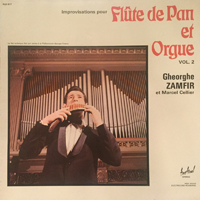
|
|
It was January 13, 1981, Tuesday around 9 in the morning ... I'll never forget it. My music teacher
Manfred Golbeck in the 9th grade at the Graf-Stauffenberg-Gymnasium in my hometown
Osnabrück brought this record to the music lessons, unaware of what he would trigger in me. Being
an enthusiast of the panflute, he wanted to bring to our students this incredible music, which was
hidden in the grooves of this LP. The Romanian panflute virtuoso Gheorghe Zamfir together with
Marcel Cellier on the organ, improvisations on Romanian folklore topics ...., he played the last
piece of the first side, "Lelita Ioana", a Geampara in 7/8 beat.
What happened to me at that moment, I remember very well, yet I still have not found the right
words to describe what this music triggered in me, being fourteen years old. Three "flashes" hit me
out of the blue, once this incredible Romanian panflute with its unique sound, the enchanting
Romanian music and the absolutely unique musical connection of panflute and organ, which was
an idea or rather an "inspiration" of the Swiss ethnomusicologist Marcel Cellier, who played the
organ himsleves and, with his idea, initiated the world career of Zamfir.
Now I was like "bewitched", took the record on loan home with me to be able to make a copy with
my homemade turntable. Why did my music teacher at grammar school now introduce us to Zamfir
and his panflute? Two weeks later Zamfir was to give a concert in Osnabrück, in the Katharinen
church, to which he wanted to draw our attention.
In these two weeks, until the 27th of January, I had no peace. I absolutely had to attend this concert,
even if the admission price of DM 21,50 for a 14-year-old student was really not insignificant back
then ..., it turned out to be the best investment of my life. After I had put dishes into and remowed
them from the dishwasher x times, mowed the lawn several times, also unnecessarily, and had done
other services in my parents' household, a little money had come together so that I could afford the
concert ticket. On that wet, cold January night, my dad drove me into town, and I was supposed to
call him from the phone booth a little farther if I wanted to be picked up. Full of anticipation and
with a pounding heart I sat with my eyes fixed on the organ loft, where there was also a table on
which four panflutes of Zamfir were shown in different sizes. Just so impressed by the sight, even
before the first note sounded, I knew that I would go through life as a panflutist.
Made a virtue out of necessity:
And now ? Of course, the concert left its impressive traces in my young heart. Zamfir was again far
away and I back in my inevitable school life. How should I just start as a panflutist? There was
nothing at that time, no panflutes in the music shops, even remotely resembling the flutes of Zamfir,
no panflut teacher, no literature, just nothing that could help. And to travel to Romania at
Ceausescu's time as a 14-year old, impossible !!! What was there? In some flower and pet shops you
could possibly find one or the other bamboo pole, and so it started! Adventurous, balancing on the
bike and on the shoulder, I brought them home through city traffic to the outskirts of the city,
obsessed with the idea to build myself a panflute, if there was no other option. I did not know
otherwise at that time (how should I) and so I built my first panflutes "chromatically", for each
semitone step a seperate tube. Also, I was not sure, since I already played the piano, if I should
rather not have the low notes on the left side, so I built the very first flute just to be able to play
them from both sides, how funny! With the second flute, which was already bent, I had quickly
decided on the traditional playing direction, and proudly present both flutes on these pictures:
From now on, I used every free minute to play everything that came to my mind, or rather, my ears
on my first homemade panflute. Whenever pocket money allowed, I bought Zamfir's records with
Romanian music, and then just play with the recordings at home .... and that was pretty good soon.
Thus, I learned the first steps on the panflute in the truest sense of the word "playful", without sheet
music or teachers, because that did not exist. The pieces became more demanding, so I also tried to
improve the flutes in order to do justice to the music. After almost a year and armed with the
seventh self-made chromatic panflute, I had the chance to meet Zamfir at a concert in Münster. The
concert was canceled, "the artists are still stuck in the snow" was said to the disappointed audience
and we were sent home. I did not want to believe that and disappeared behind the stage, heard
voices at the end of a corridor, and when a door opened from the side, Maestro Zamfir suddenly
stood in front of me and looked at me wondering what I was looking for there. He took me to his
musicians, Efta Botoca - violin, Pavel Cebzan - clarinet, Dorin Aurel Cuibaru - taragot, Petru
Vidrean - double bass, Marin Chisar - fluir / caval, Ilie Alecu - tambal. There I grabbed panflute no.
7 with slightly shaking knees and played a lively banat dance for Zamfir. But more important to me
was that Zamfir would examine my panflute, and visibly amused, he let himself be persuaded to
find out at once that the tubes were in chromatic arrangement. After all, the flute was now refined
by an autograph of Zamfir, and I learned in this way that the traditional Romanian panflutes should
be tuned in G major, additional "black keys" are played with appropriate playing technique and the "basic equipment" shoule be an instrument of 22 tubes, G1-G4. Despite this knowledge and with
childlike naivety, I nevertheless continued my chromatic panflute journey for another year, because
in my own way I enjoyed being able to play completely independently of keys without thinking,
what I heard in my mind and could have sung. In this time, I created more chromatic panflutes,
constantly trying to improve my craft technique as well as the craft. Then I met the panflute player
Horea Crishan, who was living in Hamburg. The concertmaster of the Osnabrück Symphony
Orchestra Horst Hegel had kindly arranged the contact, and he could hardly believe what virtuosity
I had achieved in Romanian music and on my chromatic panflutes. As a studied classical violinist,
however, he also recognized that my chromatic panflutes had now reached a playing-technical limit
that did not allow for any further improvements, and so he was able to convince me that I absolutely
needed to take the step towards the "right "panflute. He was completely right!
About half a year later, these picutres were taken, in the spring of 1984:
"Workshop" 1984, the beginnings
(For an enlarged view of the pictures please click on the small pictures.) |
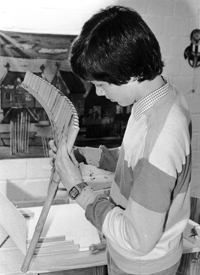
Selecting the tubes in comparison with a finished flute
|
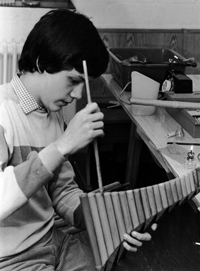
Tuning with beeswax |
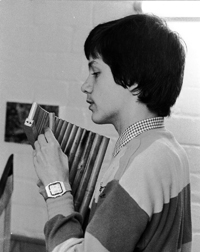
Selecting the tubes in comparison with a finished flute
|
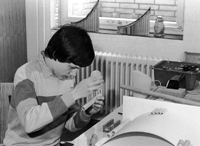
Gluing the pipes |
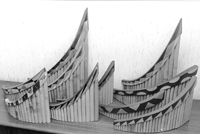
The last chromatic and the first diatonic panflutes |
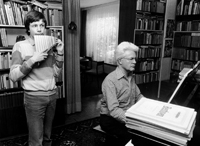
First "test" of a new flute with my dad on the piano |
Only a few months were to pass in which I built a whole series of "normal" panflutes, until I took
the next and somewhat adventurous step, which was to serve my career as a panflutist rather than
my advancement in panflute building. In my search for records with Romanian and Eastern
European music (the virus had infected me long ago), I came across the name "Marcel Cellier"
again and again, not only as Zamfir's accompanist on the organ, but above all as a producer of many
wonderful records under the label "Disques Cellier". Very quickly I realized that the recordings and
music were always of exceptional quality when the record came from Cellier, whether it was music
from Hungary, Romania, Bulgaria, Serbia or Albania. All the productions were very elaborate, with
lots of pictures and informative texts, and I understood by reading between the lines that here a
whole family full of enthusiasm for the folklore of Eastern Europe published wonderful recordings,
pictures and texts ....., naturally I wanted to get to know them. In the summer of 1983, alone at
home in the evening, I took courage and the telephone, called Marcel Cellier in Lutry on Lake
Geneva and felt like a fan of Michael Jackson, who tries to call his idol in person. I will never forget
the unbelievable warmth and enthusiasm how Marcel listened to me about my beginnings with the
panflute, as I played for him on the telephone and spontaneously he invited me: "... you must to
come for a visit, immediately! " - these were his words, and they were meant seriously! About three
months later I was there and got to know a world that was so completely different from what I was
used to from northern Germany. It would go beyond the scope of this website, if I would now
continue to tell what I experienced through this encounter with the "Cellier Family" until today, as
they have accepted me as the "adopted son", our common and sometimes adventurous journeys
through Eastern Europe, infinitely shared joy and shared suffering. It is much more than friendship,
which has been connecting us for more than thirty years. How grateful you must be if you, like me
at the beginning of my career as a panflutist, can record your first CD together with Marcel Cellier
on the organ, the "inventor" of the combination panflute and organ, right where the panflute story
started outside Rumania, where the record that turned my life upside down was recorded, in the
church of Cully on Lake Geneva .... that was in 1990, 20 years after Zamfir.
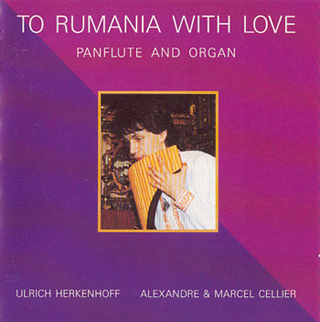
My first CD, with Marcel Cellier at the organ in Cully on Lake Geneva.
|
|
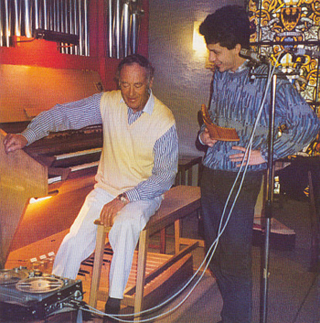
"Listen!" First appraisal with the small Nagra tape recorder.
|
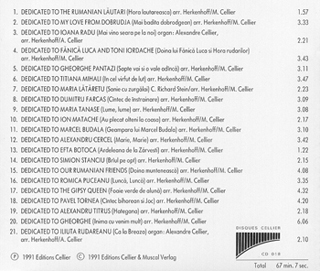
CD-Index |
|
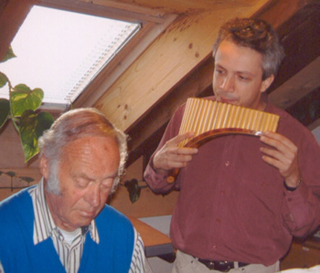
A few years later improvising during dinner at Alexandre Celliers house. |
Shortly after my first "excursion" to the "Musical-Romanian Embassy" in Switzerland, the house of
Marcel Cellier on Lake Geneva, I got to know the Bulgarian flutist and pianist Georgi Gürovby a
lucky coincidence in my hometown Osnabrück . We understood each other immediately and played
together until my graduation, civil service and music studies in Munich during many performances
and concerts, also for television. If you want to read how "The Herkenhoff" continued as a
musician, I kindly refer you to my website www.art-of-pan.de, because this is about the making of a
panflute.
As I have already described in detail, making the flute was, in the truest sense of the word, a
necessity for me, because I needed good instruments if I wanted to be a panflute player ....
instruments that were very bad at first under these conditions. Naturally, the two activities have
fabulously complemented and inspired each other, and so I can say today, after I have now made
nearly 1200 panflutes, that the number 27 was the first really good flute. Every instrument that I have
personally built for myself and played in the concerts has remained in my possession. But with
increasing concert activity, I permanently got inquiries, if I had flutes for sale or if you could order
them from me. People, who had heard me and my flutes in concerts or later on various CDs, trusted
me as a panflute maker right away. Of course, I was very grateful for that, and because I never
wanted to disappoint that confidence, I have always attached great importance to ensuring that my
sold flutes are of the same quality as those I have played myself. During my time studying music in
Munich, I always had a workbench and a good stock of bamboo pipes in various student stalls, so I
was able to turn the panflute making into a welcome additional income and keep my first car, a
rusty Fiat, for several years. Of course, my bamboo sources had become professional as well, so
today I buy from wholesalers who receive different kinds of bamboo directly from Asian countries
like China, Indonesia or Taiwan. The so-called "yellow Chinese bamboo" is currently very relevant.
After completing my studies in Munich, I had rented a small basement room in the immediate
vicinity of my apartment in the city center for a few years, but it was soon too small for my
workshop. Finally, I moved back to my parents' home in Osnabrück with the workshop, where I was
able to set up a large basement room solely for me, in order to expand the workshop there. This, of
course, was also a pleasure for my parents, because now I was often back in the "far north",
spending two weeks there two or four times a year, to disappear from morning to night in the dust
of my workshop and to possibly finish all flutes ordered in the meantime. From this time to mid-
2015, these pictures show this workshop ...., in a tidy condition:
Workshop in Osnabrück, until mid-2015
(For an enlarged view of the pictures please click on the small pictures.) |
And now ? After a total of 25 years in Munich, I moved to Reutlingen, south of Stuttgart and next to
Tübingen, into a wonderful rooftop maisonette apartment on the most beautiful square in the old
town, and feel very well there, and my workshop is there since September 2015. Now I have even
more space and thus the opportunity to put some of the invention into action for my workshop. An
immense amount of bamboo is still stored in Osnabrück, where it is step by step pre-sorted by me to
tube assortments of ordered and yet unordered flutes. The "rest" is now in Reutlingen in Swabia, so
the latest pictures of the workshop are:
Workshop in Reutlingen, since mid-2015
(For an enlarged view of the pictures please click on the small pictures.) |
And where does the name "Ulitza" come from for my panflutes? During my studies in Munich I
mainly counted fellow students from Eastern Europe because of my special musical interest to my
close circle of friends. In the Slavic languages such as Bulgarian or Serbian / Croatian, I quickly
noticed, the syllable "tza" is added to a name as a verniedization or as a "nickname". So Marina
became Marinitza, or Sandra Sandritza, where her friend Hermann "mutated" to Hermannitza. Thus,
I concluded, due to my name Uli I have to be called Ulitza ...., that was and is very funny for all
with Slavic mother tongue, because Ulitza means translated as much as road or path. Still today my
friends call me like that, and to buy an Ulitza panflute is certainly not the only possible, but
certainly a good “way” to start playing the panflute ;-)
Ulrich Herkenhoff, April 2016
|